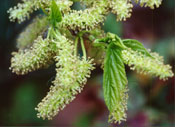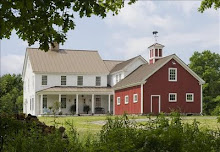Allergy-Free Gardening pioneer, Thomas Leo Ogren
I have a special treat to share with you today on THE CONCORD GREEN blog - an interview with Thomas Leo Ogren.
Motivated by the allergy and asthma suffering in his own family, Tom created the Ogren Plant Allergy Scale (OPALSTM), the first and only numerical plant-allergy ranking system in existence, which is now helping individuals, and entire cities worldwide, develop healthier landscapes.
Lisa: Tom, thank you so much for joining us today. So, it seems that our modern landscaping habits have actually created an allergy nightmare. How did you first realize this?
Tom: Twenty some years ago I was trying to get close up photos of both male and female flowers of separate-sexed landscape trees and shrubs. I quickly found that I was able to find all the male plants I needed, but that finding the female plants was hard, and sometimes impossible. At first I thought this was just in my own town, San Luis Obispo, California…but as I went to other towns, other states, even other countries…everywhere I found the same problem. There were always lots of male trees and shrubs, and almost never were there many female ones.
I knew by then that of course the male plants were the ones shedding the allergenic pollen, and was very curious as to why there were so few females around. Eventually I figured it out; the plant propagators were only producing male clones, because they didn’t shed any old flowers or fruit, or seedpods. These were “litter-free” plants…but of course, they were very allergenic.
Photo: TreeHugger
Lisa: Please talk a bit about how your OPALS system works.
Tom: I’ve evaluated thousands of landscape plants on their potential to cause, or not to cause, allergies. Early on I realized that most people are not horticulturists, most folks don’t know all that much about plants. I needed a system that made it all simple and easy to understand. OPALS, which stands for Ogren Plant Allergy Scale, ranks all the landscape plants one to ten….where one is least allergenic, and where ten is very allergenic. The system has been used now by a great many different landscapers, designers, government organizations, etc. and even if it isn’t perfect, it does work.
Male Mulberry Tree. Highly Allergenic.
OPALS™ rank=10
OPALS™ rank=10
Each OPALS ranking is based on different various plus or negative factors that might affect allergy potential. For example, if a plant is closely related to a family well known to cause many allergies…than that is a strong negative, a red flag. Likewise, if a plant produces a large amount of very tiny pollen, and does so over a prolonged period of time, that too is another strong negative.
Petunia 'Purple Wave'. Allergy Friendly.
OPALS™ Rank=1
OPALS™ Rank=1
Certain factors are plus, for example: a plant with highly colored flowers will normally rely on insects (not the wind) to pollinate it…thus this is a plus factor. A plant with flowers that are “perfect” (meaning it has a complete set of both male and female parts in the same flower) is also a plus…is another indication of insect pollinization.
With OPALS, up to 130 different plus or minus factors are evaluated and a score is made, and from that the 1-10 ranking is figured out.
Lisa: What do you see as the biggest advances since the release of your landmark book, Allergy-Free Gardening?
Tom: Allergy-Free Gardening was published in 2000, and then republished four years later, both times by Ten Speed Press. Ten Speed has since been bought by a much larger publisher, Random House, and I can only hope they will keep the book alive and in print.
There has been much progress in certain places, and none in many others. In New Zealand, for example, in both Auckland and in Christchurch, all the city landscaping is now done to be as allergy-free as possible. This is a result of talks I gave in New Zealand several years ago.
In the US and in Canada there are a number of cities that are making a real attempt to landscape with allergy-free trees…cities like Albuquerque, NM, Las Vegas, NV, Tucson, AZ, and so on.
Soon after the publication of AFG the American Lung Association hired me to landscape their headquarters in Richmond, VA, with an allergy-free landscape.
Recently the New York Times hired me to write an Op-Ed piece on why New York City should start paying attention to the allergy potential of the city trees it plants.
But I must add, in most cases city arborists are dragging their feet…they are not doing nearly as much as they could, and should for those with allergies, and or, with asthma.
Lisa: Let’s get specific. What are the top 3 priorities for individuals who want to create their own healthy landscape?
Tom: The first thing is to identify the most allergenic trees and shrubs in the yard, and then remove them.
The second most important thing is for people to then replace all of the worst plants with either pollen-free plants, or at least with plants that have very low OPALS numbers…those least likely to trigger allergies.
The third most important part is for people with asthma and allergies to stand up and speak out! No one else will do it for them. People should demand that their own cities stop planting any more male clonal trees. They should insist that their own cities start producing street trees and city landscapes that will be allergy-friendly…not allergy-causing. People with allergies need to get political, just as folks from other groups have…for example, look how organized women now are against breast cancer. That’s terrific. The same thing should happen with allergies.
Lisa: What about the age old “turf battle” – the lawn? Is it really possible to have a low-maintenance, chemical- and allergy-free lawn that looks good?
Tom: Tall fescue grass is easy to find and easy to grow. If kept mowed on a regular basis, it will almost never bloom and produce any pollen. A good, thick, healthy lawn is a great pollen trap. Pollen from trees and shrubs lands on the lawn, and it doesn’t get back into circulation.
There are other low-pollen and even some totally all-female, pollen-free lawn grasses we can use. I wrote a book just about lawns, and all this is covered in it, in great detail. But my main point here is that a good lawn is the best groundcover of them all, and if done right, it need not be a source of allergies.
Lisa: Any specific landscape recommendations for the CONCORD GREEN HEALTHY HOUSE?
Tom: I’d like to see them using some edibles in the landscape…plants like plum trees, blueberry bushes, strawberry plants, etc. None of these triggers allergies.
I’d like to see the CONCORD GREEN HEALTHY HOUSE use their own landscape as a learning tool….complete with good plant tags that explain why each plant was used.
I’d like to see them use some attractive female trees, and female shrubs too…for example, it would be good to use both female junipers and female yews.
While they were at it they could also use some pollen-free ground cover, or at least some that is very low allergy. CONCORD GREEN HEALTHY HOUSE is a great idea!
Lisa: Lastly, how can we motivate more nurseries, landscape designers, school, hospital and town planners, and anyone else responsible for landscape decisions that affect us all, to heed the wisdom of the OPALS ranking system?
Tom: Each of us has to do our part. We need to talk to people we know about this, we need to talk to the people at the nurseries, the landscape designers, school, hospital and town planners, and everyone else responsible for landscape decisions that directly affect us. We need to act locally, need to go and talk to our city council members about this. In some cities they’ve enacted pollen-control ordinances, and they no longer permit the sale or planting of the most allergenic trees and shrubs. That ought to be the goal for anyone concerned about making a difference in the lives of those with asthma or allergies.
Lisa: Thank you again for your time today, and for your ground-breaking work that has already helped so many.
Tom: My pleasure, Lisa. Excellent questions, too, I might add. Please do keep in touch.
Lisa: Will do. Please let us know when you next come east, as we would be thrilled to host one of your talks in town.
To learn more, please visit Tom's website. You can order his books from from Amazon via THE CONCORD GREEN Bookshop here.
To learn more, please visit Tom's website. You can order his books from from Amazon via THE CONCORD GREEN Bookshop here.





































No comments:
Post a Comment